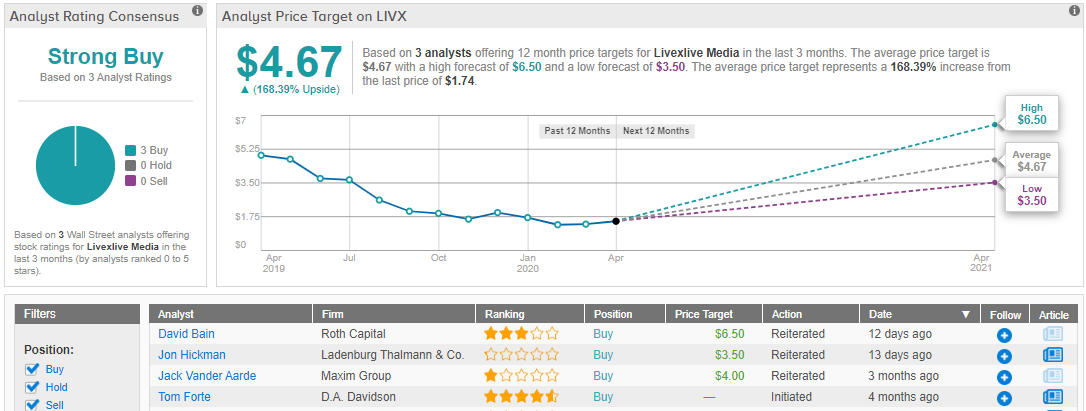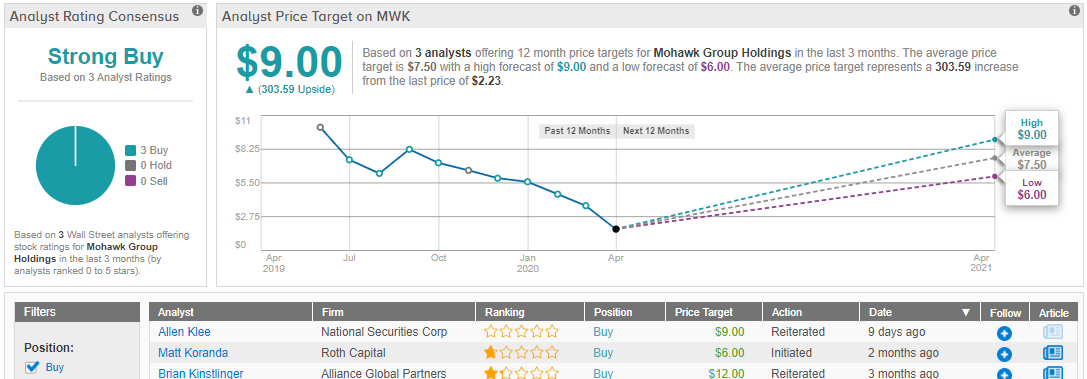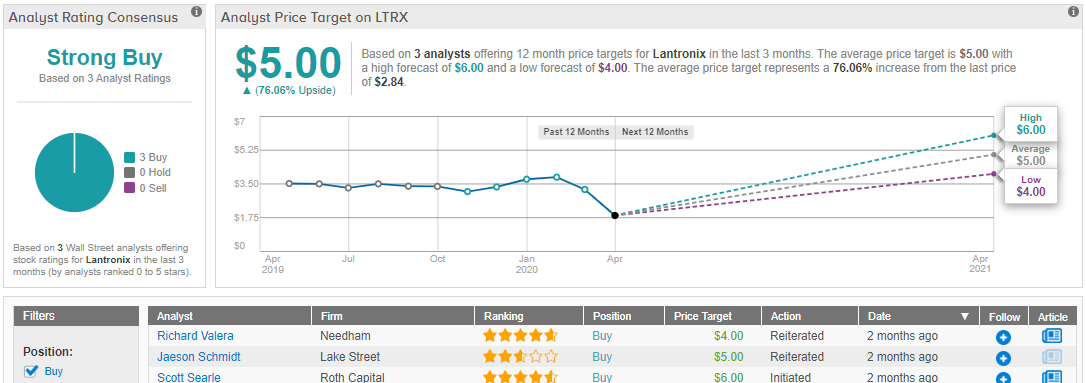The possibility of a breakout, and the chance to reap rewards, may be closer than we think. Writing from JPMorgan, quant analyst Marko Kolanovic sees the main chance turning toward a 2H20 economic recovery and new market records by 1H21. He bases his stance on new data showing that the COVID-19 pandemic may have already peaked, and that the worst-case scenario is unlikely to come about. With that in mind, the Fed’s stimulus and Congress’ monetary aid will be more important factors than poor earnings in the first half of this year. He states, “The combined suppression of the risk-free rate and credit spreads by the Fed likely has a bigger positive impact on equity valuation, compared with the negative impact of the temporary earnings loss.”
It’s a situation that gives investors an incentive to buy. We’re not in a true bull market – not by a long shot – but the recent bear has pushed prices down and the current rally is opening up the prospects of gains. All that remains is finding the right stocks to buy.
And this brings us to penny stocks, those low-cost equities priced below $5 per share – are a high-stakes opportunity with upsides that frequently approach several hundred percent and a low enough cost of entry to mitigate the attendant risk. These companies are priced low for a reason, but for those that break out, the rewards are tremendous.
We’ve opened up the TipRanks database to find three Strong Buy penny stocks with upwards of 70% upside potential. These are companies that Wall Street’s analyst corps sees as ready to jump.
LiveXLive Media (LIVX)
We’ll start with a player in the digital media industry, a niche that is almost certain to see gains as the lockdowns and shutdowns drag on and people seek out entertainment available from their homes. LiveXLive operates music and video streaming platforms, taking live entertainment online. The company delivers livestreams, music on-demand, digital audio, and even a live social music network.
Since the second quarter 2019, LIVX’s quarterly earnings, while still showing net losses, have been improving, with smaller losses sequentially. The fiscal Q3 results, at minus 15 cents, beat the forecast by 2 cents, and the fiscal Q4 results, covering the first quarter of 2020, is projected at a net loss of 16 cents, a 15% gain year-over-year.
With a price tag of $1.74 per share, analysts believe that now is the time to pull the trigger.
Covering the company for Roth Capital, analyst David Bain writes of LiveXLive: “We believe the current COVID-19 environment accelerates LIVX’s roadmap to profitability and more acutely positions LIVX as the number one digital broadcaster of live music… As the top-digital live music broadcaster, we believe LIVX is contracting with multiple touch-points, rapidly filling the content funnel at little to no cost. At the same time, distributors, social, pay and VOD, TVOD, AVOD and emerging global distribution verticals are facing a strong need for unique music channels/content, particularly in the at-home consumer setting.”
It is no surprise that Bain reiterates his Buy rating on this stock, nor that his $6.50 price target suggests a robust 230% upside potential for the coming year. (To watch Bain’s track record, click here)
Small cap stocks like LiveXLive typically get fewer analyst reviews than the corporate giants, but the consensus of the analysts who look at LIVX is a Strong Buy – and it is unanimous. All three recent reviews have rated the stock a Buy. The average price target is $4.67 and implies nearly 170% upside from current levels. (See LiveXLive stock analysis on TipRanks)
Mohawk Group Holdings (MWK)
Next up is Mohawk, a micro-cap company in the consumer tech industry. Mohawk’s AI system analyzes real-time shopping data to determine what customers want for and from in-home items such as kitchen sets, beauty products, appliances, and other homewares, and uses that information to guide product development, production, and shipping. It’s a unique, data-centered take on the consumer economy.
A measure of the company’s fundamental soundness can be seen in the preliminary Q1 announcement, indicating that first quarter revenue will come in the range of $25 to $26 million. That result, while flat sequentially, will demonstrate 43% year-over-year growth, a strong result during a quarter full of economic, especially retail, disruptions.
Mohawk shares have surged 32% in just the last month, but at $2.23 apiece, several analysts believe this stock is still undervalued.
Allen Klee, reviewing Mohawk for National Securities, believes that MWK shares are undervalued currently, writing, “MWK [has] significantly faster growth rates than traditional CPG Companies. We could also argue that MWK can be viewed as blend of CPG and a software/machine learning company where comps for latter trade at even higher multiples. We believe the pullback in the stock is not warranted as fundamentals remain solid and the company is positioned to outperform in current difficult economy.”
Klee reiterates his Buy rating on the stock, and raises his price target to $9.00, showing his confidence and implying a truly impressive upside potential here of 304%. (To watch Klee’s track record, click here)
Mohawk is our second stock with a unanimous Strong Buy consensus rating, also based on 3 Buy reviews. Mohawk will no longer be a penny stock, if the average price target of $9.00 will be reached over the next year. (See Mohawk stock analysis at TipRanks)
Lantronix (LTRX)
Just as the internet and wireless networking have changed the way we communicate, so the Internet of Things (IoT) is changing the way we interact with our physical environment. IoT has been gaining traction in industry for the past several years, and companies like Lantronix, that service the growing niche, have a path forward. Lantronix is a designer and developer of network device servers, optimized for the access, control, configuration, and management of IoT protocols.
In its fiscal Q2, covering the final calendar quarter of 2019, LTRX showed a considerable gain in revenue, growing 9% year-over-year and 4% sequentially to reach $13.2 million. GAAP EPS came in at a net loss, of 6 cents, which compared favorably to the 11-cent loss of the previous quarter. The company expects growth to continue, and even with current conditions and supply chain disruptions, is guiding toward $15 to $17 million in fiscal Q3 revenue. At the midpoint, this is down 11% from previous guidance but still expects 21% sequential growth.
5-star analyst Scott Searle, from Roth Capital, is bullish on IoT, and sees LTRX as a strong play in the field. He says of the company performance during the current downturn, “Importantly… end market demand appears to be healthy and the pipeline of opportunities continues to grow; including a new video conferencing customer who continues to increase orders.”
At the bottom line, Searle writes, “Lantronix is accelerating integration and cost reduction… While we are slightly lowering our near-term expectations, our CY21 estimates remain largely untouched… [we] would use current weakness as an entry point.”
Searle’s Buy position is backed by a $6 price target that indicates a 111% upside potential. (To watch Searle’s track record, click here)
Three is our lucky number today. Lantronix is the third stock on our list, the third with a Strong Buy consensus rating, and the third to base that rating unanimously on three Buy reviews. The stock is priced at just $2.84, and the $5 average price target shows room for an 76% upside potential in the next 12 months. (See Lantronix stock analysis on TipRanks)
To find good ideas for penny stocks trading at attractive valuations, visit TipRanks’ Best Stocks to Buy, a newly launched tool that unites all of TipRanks’ equity insights.




